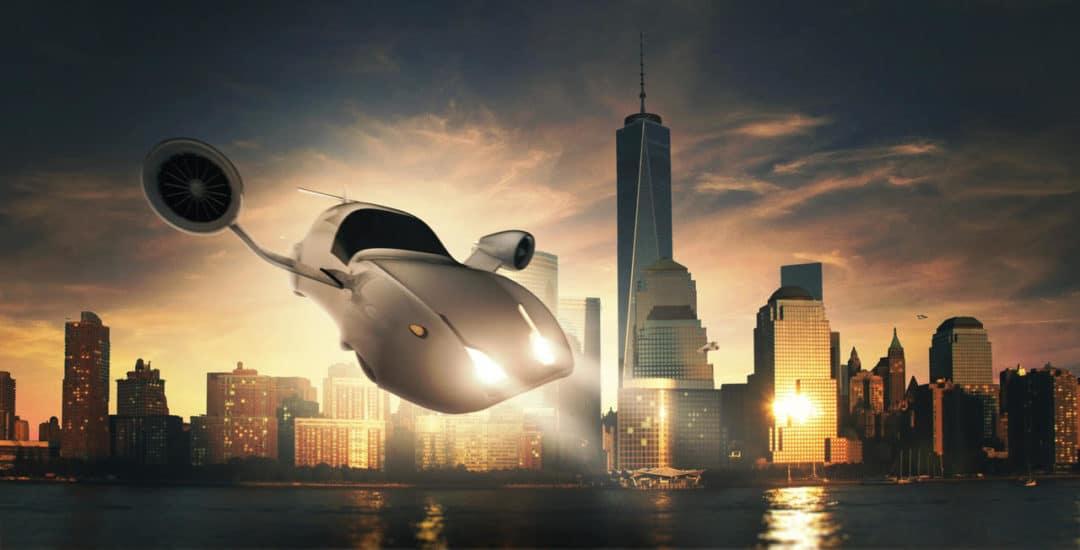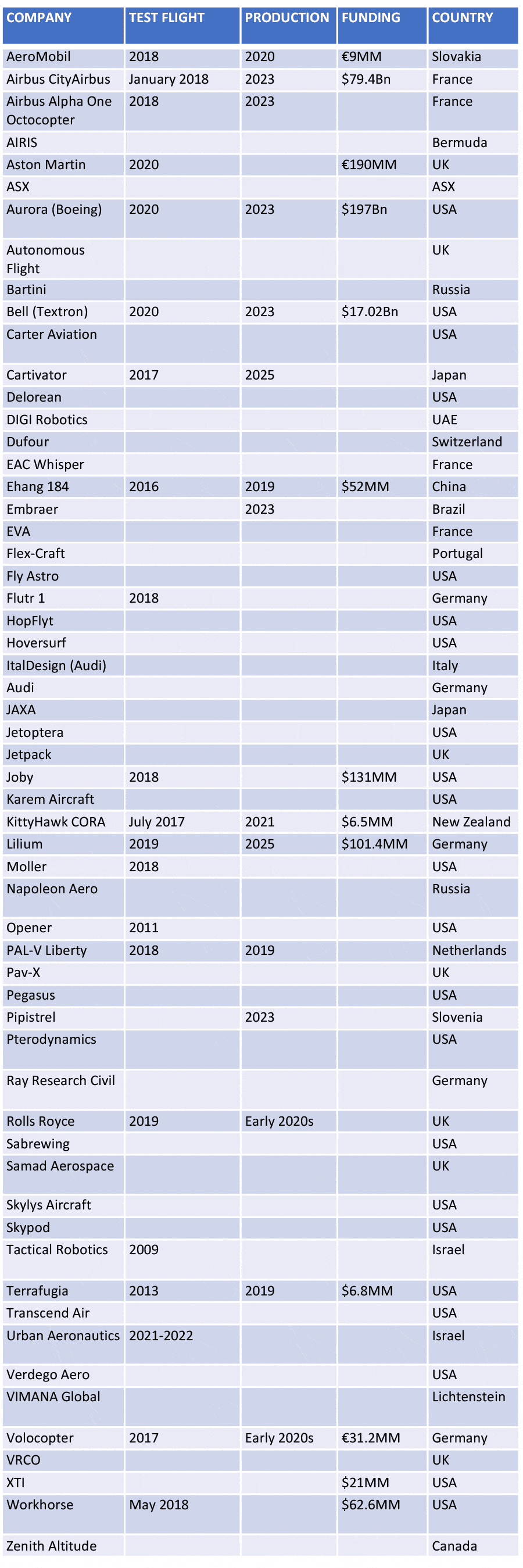Flying Car Companies Jockey for Position

While the general public is still wrapping its head around the idea of self-driving cars, companies worldwide are preparing their flying cars for takeoff.
Most, but not all, of the flying car concepts are VTOLs. Technological innovation in drone technology, electric batteries, propulsion systems, machine learning, and sense-and-avoid technology are making flying cars within reach. Some experts believe we’ll be flying in autonomous cars before we drive them.
Meet some of the key players and their machines.

A³ (Airbus)
A³ (pronounced A cubed), is the Silicon Valley arm of French aerospace giant Airbus, which is developing several eVTOL concepts. Its one-person Vahana spent about a minute in the air in early 2018. Its four-person eVTOL CityAirbus, which resembles a drone, will conduct its first test flight by the end of 2018, with the company anticipating large cities adopting it as an air taxi in pilot programs as early as 2025. The company expects it to be operated by a pilot initially, with a switch to being fully autonomous once regulations exist.
Learn more about A³’s other projects, including the Alpha One octocopter.
In April, 2018, this eight-year-old engineering firm from Slovakia launched the hybrid-electric AeroMobile 5.0 prototype, a four-wheeled, four-passenger VTOL that can be driven or flown. It’s intended to be used in metropolitan areas. The company also has a 4.0 STOL (short take-off and landing), designed to make short stops between cities. Learn about the technology behind the AeroMobil 5.0 and why it will cost consumers more than $1 million in 2020.
Aurora Flight Sciences Corporation
Acquired by Boeing in the fall of 2017, Virginia-based Aurora specializes in flight systems for pilotless electric aircraft for both military and commercial applications. It’s produced a line of small eVTOL autonomous aircraft. Learn more about Aurora.
Toyota recently invested $370,000 in this Japanese nonprofit, which is developing a road/air quadrotor craft called SkyDrive that is aiming to light the torch in the 2020 Tokyo Olympics. The aerial car’s rotors remain folded while being driven on the road and unfold when transitioning to flight mode. The first commercial model is expected by 2025.
Currently, the Ehang 184, an egg-shaped autonomous quadcopter, can carry one passenger who weighs a little over 200 pounds about 10 miles. The passenger doesn’t fly the craft; he simply sets the flight path into the computer and pushes a button. The idea of this excites some people and terrifies others. For the past several years, the Chinese company has conducted more than 1,000 test flights through adverse conditions on its quest to improve systems. Read about a potential use for Ehang’s technology that may save lives in the future.
Joby Aviation
This is a secretive but well-funded Santa Cruz, CA, start-up that’s reportedly begun testing its autonomous air taxi prototype along the Californian coast. The very few renderings that have been released over the years show a plane-drone hybrid with 12 rotors. In early 2018, the company raised $100 million from investors, including Intel, Toyota, and JetBlue. Company founder, JoeBen Bevirt, plans on adding 100 engineers to his team of 120 employees.
This California-based company is owned by Google cofounder, Larry Page, who tapped Sebastian Thrun, who helped start Google’s autonomous car unit, as CEO. Cora, its electric, two-seat flying taxi, is well into testing in New Zealand with a commercial network expected to be operating in New Zealand in three to six years.
This German company hired Frank Stephenson, designer of the McLaren P1, to reimagine cars for the sky. He’s lending his imagination to Lilium’s five-seat, tilt-wing eVTOL that will be powered by 36 electric engines on its wings. The prototype will be capable of transitioning from dronelike hover mode into wing-borne flight and will fly as fast as 186 mph with a range of about 190 miles before it needs recharging. Commercial air taxi service in the US and other regions is expected by 2025. Learn more about Lilium.
The Dutch manufacturer revealed the PAL-V (Personal Air and Land Vehicle) Liberty Sport at the 2018 Geneva International Motor Show. Unlike other flying car designs, the PAL-V cannot take off or land vertically and needs at least 300 feet to achieve lift off. Part car and part gyroplane, the three-wheeled Liberty Sport has two Rotax airplane engines that help it fly at a top speed of 112 mph for about 250 miles at maximum weight. On ground, the two-person, gas-powered vehicle can it about 100 mph. Transitioning the car from road to air can be done manually in five to 10 minutes. First deliveries are expected in Europe in 2019. Learn what it will take for consumers to purchase a PAL-V.
This Massachusetts company was acquired in 2017 by Zhejiang Geely Holding Group, the Chinese automotive giant that owns Volvo and Lotus. First deliveries of the Transition, a folding-wing, two-seat roadable aircraft that can convert from drive to flight mode in less than a minute, are expected by 2019. The vehicle already meets all Federal Motor Vehicle Safety Standards and runs on automotive gas.
Uber
Uber made this list, not because it plans to make VTOL aircrafts, but because it is working with aircraft manufacturers that will use its on-demand uberAIR flying taxi service, which Uber CEO Dara Khosrowshahi estimates will launch within the next five to 10 years, starting in Los Angeles, CA, and Dallas, Texas. Other potential UberAir launch cities include urban areas in Japan, France, Brazil, Australia, and India.
Long known for its prowess in the sky, the Israeli Air Force would seem a natural breeding ground for aviation innovation. So, when Dr. Rafi Yoeli, a leading Israeli aviation researcher decided to tackle flying cars, he had a deep talent pool to tap into. The team he assembled is designing flying vehicles for commercial and military applications which they expect to be operational in the 2021-2022 timeframe. Learn more about Urban Aeronautics.
This German aviation company is backed by Daimler, parent company of Mercedes, and Intel, creator of computer chips for autonomous cars and drones. Former Intel CEO Brian Krzanich flew as the Volocopter’s first public passenger at the 2018 CES tech trade show. The two-passenger eVTOL is approved as an ultralight vehicle in Germany and has been tested in Dubai. Eighteen rotors placed along a ring above the Volocopter 2X’s fuselage give it a futuristic helicopter look. It uses the same movement sensors as spacecraft to determine position and altitude, without needing GPS signals to work. The company aims to be operating an air taxi service within a decade.


